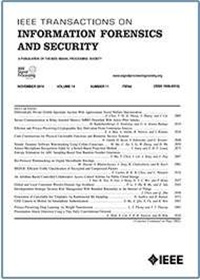一种多粒度深度信号收缩网络用于噪声鲁棒特定发射器识别
IF 8
1区 计算机科学
Q1 COMPUTER SCIENCE, THEORY & METHODS
IEEE Transactions on Information Forensics and Security
Pub Date : 2025-04-15
DOI:10.1109/TIFS.2025.3560690
引用次数: 0
摘要
无线网络安全是无线通信系统中的一个重要问题。特定发射器识别(SEI)技术作为一种有效的物理层认证方法,得到了广泛的研究。基于深度学习(DL)的SEI方法已成为主要方法,这归功于它们的端到端识别框架和增强的特征提取能力。然而,深度学习模型的训练依赖于高质量的数据,而现实场景中的数据采集往往处于低信噪比(SNR)的环境中,导致模型训练性能较差。本文提出了一种新的解决方案,即多粒度深度信号收缩网络(MGDSSN),以解决低信噪比环境下SEI的挑战性任务。为此,提出的MGDSSN结合了软阈值处理,并采用子网进行自适应阈值处理,有效地消除了噪声相关特征,并在低信噪比环境中实现了稳健的SEI。此外,MGDSSN采用了多粒度深度信号网络架构,提高了模型的识别精度和稳定性。这是通过捕获相/正交相(I/Q)信号的相关属性和多个粒度级别的特征来实现的。使用真实数据集进行的实验表明,在低信噪比环境中,所提出的MGDSSN优于当前最先进的SEI方法,展示了稳健的SEI并验证了所提出方法的优越性。本文章由计算机程序翻译,如有差异,请以英文原文为准。
A Multi-Granularity Deep Signal Shrinkage Network for Noise-Robust Specific Emitter Identification
Wireless network security is a significant issue in wireless communication systems. Specific emitter identification (SEI) technology, as an effective physical layer authentication method, has been extensively studied. Methods based on deep learning (DL) for SEI have emerged as the predominant approach, attributed to their end-to-end recognition framework and enhanced capability for feature extraction. However, the training of DL models relies on high-quality data, and the data collection in real-world scenarios is often in low signal-to-noise ratio (SNR) environments, leading to poor model training performance. This paper presents a novel solution, the Multi-Granularity Deep Signal Shrinkage Network (MGDSSN), for the challenging task of SEI in low SNR environments. To this end, the proposed MGDSSN incorporates soft thresholding processing and employs subnetworks for adaptive thresholding, effectively eliminating noise-related features and achieving robust SEI in low SNR environments. Additionally, MGDSSN incorporates a multi-granularity deep signal network architecture that improves the recognition accuracy and stability of the model. This is achieved by capturing the interrelated attributes of in-phase/quadrature-phase (I/Q) signals and features at multiple levels of granularity. Experiments conducted with real-world dataset reveal that the proposed MGDSSN surpasses the current state-of-the-art SEI methods in low SNR environments, demonstrating robust SEI and verifying the superiority of the proposed method.
求助全文
通过发布文献求助,成功后即可免费获取论文全文。
去求助
来源期刊

IEEE Transactions on Information Forensics and Security
工程技术-工程:电子与电气
CiteScore
14.40
自引率
7.40%
发文量
234
审稿时长
6.5 months
期刊介绍:
The IEEE Transactions on Information Forensics and Security covers the sciences, technologies, and applications relating to information forensics, information security, biometrics, surveillance and systems applications that incorporate these features
 求助内容:
求助内容: 应助结果提醒方式:
应助结果提醒方式:


